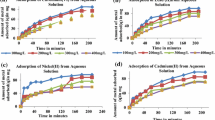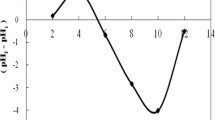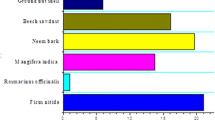Abstract
Activated carbon has been found to be useful for purification of liquids and gases via adsorption. Majority of the activated carbon which is utilized in our environment is imported and not produced locally. Activated carbon was prepared from the popular Sahel African plant; Piliostigma reticulatum and used for the extraction of hexavalent chromium [Cr(VI)] molecules from aqueous medium. The Piliostigma activated carbon was characterized using X-ray diffraction, scanning electron microscopy and Fourier transform infrared spectroscopy. The efficiency of this adsorbent to remove Cr(VI) molecules from aqueous medium was investigated at different initial concentrations, pH, contact time and adsorbent dosage. Kinetic studies showed that the adsorption process was described by pseudo-second order kinetic model and the equilibrium modelling results fitted best the Freundlich model. The maximum amount of uptake capacity achieved at pH 1.5 was 3.92 mg/g at equilibrium time of 20 min. The piliostigma activated carbon shows potential of being an environmentally friendly adsorbent for Cr(VI) extraction from contaminated water. Piliostigma reticulatum which is grown freely on the African continent can serve as a viable raw material for this purpose.












Similar content being viewed by others
References
Fasanya OO, Adesina OB, Okoduwa UJ, Abdulkadir J, Winful E, Obidah TY, Adamun SI, Audu EA, Myint MTZ, Olabimtan OH, Barminas JT (2020) Characterization of Sansevieria Liberica & Urena Lobata fibers as potential sorbent materials for crude oil clean up. J Nat Fibers 1–16. https://doi.org/10.1080/15440478.2020.1788486
Paulauskiene T, Uebe J, Karasu AU, Anne O (2020) Investigation of cellulose-based aerogels for oil spill removal. Water Air Soil Pollut 231(8):424
Massai H, Djakba R, Sali MY, Yasin B, Teknologi U, Shah M (2020) Adsorption of copper ions (Cu++) in aqueous solution using activated carbon and biosorbent from Indian Jujube (Ziziphus mauritiana) seed hulls. Chem Sci Int J 29(5):13–24
Naseem K, Huma R, Shahbaz A, Jamal J, Ur Rehman MZ, Sharif A, Ahmed E, Begum R, Irfan A, Al-Sehemi AG, Farooqi ZH (2019) Extraction of heavy metals from aqueous medium by husk biomass: adsorption isotherm, kinetic and thermodynamic study. Z Phys Chem 233(2):201–223
Noor NM, Othman R, Mubarak NM, Abdullah EC (2017) Agricultural biomass-derived magnetic adsorbents: preparation and application for heavy metals removal. J Taiwan Inst Chem Eng 78:168–177
Qin H, Hu T, Zhai Y, Lu N, Aliyeva J (2020) The improved methods of heavy metals removal by biosorbents: a review. Environ Pollut 258:113777
Şenol ZM (2020) Effective biosorption of Allura red dye from aqueous solutions by the dried-lichen (Pseudoevernia furfuracea) biomass. Int J Environ Anal Chem 1–15. https://doi.org/10.1080/03067319.2020.1785439
Reza MS, Yun CS, Afroze S, Radenahmad N, Bakar MSA, Saidur R, Taweekun J, Azad AK (2020) Preparation of activated carbon from biomass and its’ applications in water and gas purification, a review. Arab J Basic Appl Sci 27(1):208–238
Danish M, Ahmad T (2018) A review on utilization of wood biomass as a sustainable precursor for activated carbon production and application. Renew Sustain Energy Rev 87:1–21
Rattanapan S, Srikram J, Kongsune P (2017) Adsorption of methyl orange on coffee grounds activated carbon. Energy Procedia 138:949–954
Farnane M, Tounsadi H, Machrouhi A, Elhalil A, Mahjoubi FZ, Sadiq M, Abdennouri M, Qourzal S, Barka N (2017) Dye removal from aqueous solution by raw maize corncob and H3PO4 activated maize corncob. J Water Reuse Desalination 8:jwrd2017179
Djilani C, Zaghdoudi R, Djazi F, Bouchekima B, Lallam A, Modarressi A, Rogalski M (2015) Adsorption of dyes on activated carbon prepared from apricot stones and commercial activated carbon. J Taiwan Inst Chem Eng 53:112–121
Kwiatkowski M, Broniek E (2017) An analysis of the porous structure of activated carbons obtained from hazelnut shells by various physical and chemical methods of activation. Colloids Surf A Physicochem Eng 529:443–453
Valentín-Reyes J, García-Reyes RB, García-González A, Soto-Regalado E, Cerino-Córdova F (2019) Adsorption mechanisms of hexavalent chromium from aqueous solutions on modified activated carbons. J Environ Manag 236:815–822
Wilbur S, Abadin H, Fay M, Yu D, Tencza B, Ingerman L, Klotzbach J, James S (2012) Toxicological profile for chromium. Agency for Toxic Substances and Disease Registry (US), Atlanta
Ma J, Li J, Guo Q, Han H, Zhang S, Han R (2020) Waste peanut shell modified with polyethyleneimine for enhancement of hexavalent chromium removal from solution in batch and column modes. Bioresour Technol Rep 12:100576
Saha R, Nandi R, Saha B (2011) Sources and toxicity of hexavalent chromium. J Coord Chem 64(10):1782–1806
Mondal MH, Begum W, Nasrollahzadeh M, Ghorbannezhad F, Antoniadis V, Levizou E, Saha B (2021) A comprehensive review on chromium chemistry along with detection, speciation, extraction and remediation of hexavalent chromium in contemporary science and technology. Vietnam J Chem 59(6):711–732
Wang B, Sun Y-C, Sun R-C (2019) Fractionational and structural characterization of lignin and its modification as biosorbents for efficient removal of chromium from wastewater: a review. J Leather Sci Eng 1(1):5
Owlad M, Aroua MK, Daud WAW, Baroutian S (2009) Removal of hexavalent chromium-contaminated water and wastewater: a review. Water Air Soil Pollut 200(1):59–77
Qhubu MC, Methula B, Xaba T, Moyo M, Pakade VE (2021) Iron-zinc impregnated biochar composite as a promising adsorbent for toxic hexavalent chromium remediation: kinetics, isotherms and thermodynamics. Chem Afr. https://doi.org/10.1007/s42250-021-00273-5
Ugwu EI, Agunwamba JC (2020) A review on the applicability of activated carbon derived from plant biomass in adsorption of chromium, copper, and zinc from industrial wastewater. Environ Monit Assess 192(4):240
Yin W, Guo Z, Zhao C, Xu J (2019) Removal of Cr(VI) from aqueous media by biochar derived from mixture biomass precursors of Acorus calamus Linn. and feather waste. J Anal Appl Pyrolysis 140:86–92
Lace A, Ryan D, Bowkett M, Cleary J (2019) Chromium monitoring in water by colorimetry using optimised 1,5-diphenylcarbazide method. Int J Environ Res Public Health 16(10):1803
Bright MBH, Diedhiou I, Bayala R, Assigbetse K, Chapuis-Lardy L, Ndour Y, Dick RP (2017) Long-term Piliostigma reticulatum intercropping in the Sahel: crop productivity, carbon sequestration, nutrient cycling, and soil quality. Agric Ecosyst Environ 242:9–22
Boualam K, Ndiaye B, Harhar H, Tabyaoui M, Ayessou N, Taghzouti K (2021) Study of the phytochemical composition, the antioxidant and the anti-inflammatory effects of two sub-saharan plants: Piliostigma reticulatum and Piliostigma thonningii. Adv Pharmacol Sci 2021:5549478
Kayiwa R, Kasedde H, Lubwama M, Kirabira JB (2021) The potential for commercial scale production and application of activated carbon from cassava peels in Africa: a review. Bioresour Technol Rep 15:100772
Abatan OG, Oni BA, Agboola O, Efevbokhan V, Abiodun OO (2019) Production of activated carbon from African star apple seed husks, oil seed and whole seed for wastewater treatment. J Clean Prod 232:441–450
Rahman A, Hango HJ, Daniel LS, Uahengo V, Jaime SJ, Bhaskaruni SVHS, Jonnalagadda SB (2019) Chemical preparation of activated carbon from Acacia erioloba seed pods using H2SO4 as impregnating agent for water treatment: an environmentally benevolent approach. J Clean Prod 237:117689
Omorogie MO, Babalola JO, Ismaeel MO, McGettrick JD, Watson TM, Dawson DM, Carta M, Kuehnel MF (2021) Activated carbon from Nauclea diderrichii agricultural waste—a promising adsorbent for ibuprofen, methylene blue and CO2. Adv Powder Technol 32(3):866–874
Prakash MO, Raghavendra G, Ojha S, Panchal M (2021) Characterization of porous activated carbon prepared from arhar stalks by single step chemical activation method. Mater Today Proc 39:1476–1481
Nagy B, Măicăneanu A, Indolean C, Mânzatu C, Silaghi-Dumitrescu L, Majdik C (2014) Comparative study of Cd(II) biosorption on cultivated Agaricus bisporus and wild Lactarius piperatus based biocomposites. Linear and nonlinear equilibrium modelling and kinetics. J Taiwan Inst Chem Eng 45(3):921–929
Bopda A, Raoul TD, Tchuifon T, Ndifor-Angwafor N, Doungmo G, Gabche A (2019) Non-linear equilibrium and kinetic study of the adsorption of 2,4-dinitrophenol from aqueous solution using activated carbon derived from a olives stones and cotton cake. Afr J Environ Sci Technol 13:365–380
Kim JY, Balathanigaimani MS, Moon H (2015) Adsorptive removal of nitrate and phosphate using MCM-48, SBA-15, chitosan, and volcanic pumice. Water Air Soil Pollut 226(12):431
Hossain MD, Ngo H, Guo W (2013) Introductory of Microsoft Excel SOLVER function-Spreadsheet method for isotherm and kinetics modelling of metals biosorption in water and wastewater. J Water Sustain 3:223–237
Amrhar O, Nassali H, Elyoubi M (2015) Application of nonlinear regression analysis to select the optimum absorption isotherm for Methylene Blue adsorption onto Natural Illitic Clay. Bull Soc R Sci Liege 84:116–130
Ayawei N, Ebelegi AN, Wankasi D (2017) Modelling and interpretation of adsorption isotherms. J Chem 2017:3039817
Sangkarak S, Phetrak A, Kittipongvises S, Kitkaew D, Phihusut D, Lohwacharin J (2020) Adsorptive performance of activated carbon reused from household drinking water filter for hexavalent chromium-contaminated water. J Environ Manag 272:111085
Zhao J, Yu L, Ma H, Zhou F, Yang K, Wu G (2020) Corn stalk-based activated carbon synthesized by a novel activation method for high-performance adsorption of hexavalent chromium in aqueous solutions. J Colloid Interface Sci 578:650–659
Rai MK, Shahi G, Meena V, Meena R, Chakraborty S, Singh RS, Rai BN (2016) Removal of hexavalent chromium Cr (VI) using activated carbon prepared from mango kernel activated with H3PO4. Resour Eff Technol 2:S63–S70
Zhou H, Bhattarai R, Li Y, Li S, Fan Y (2019) Utilization of coal fly and bottom ash pellet for phosphorus adsorption: sustainable management and evaluation. Resour Conserv Recycl 149:372–380
Enniya I, Rghioui L, Jourani A (2018) Adsorption of hexavalent chromium in aqueous solution on activated carbon prepared from apple peels. Sustain Chem Pharm 7:9–16
Sun L, Yan C, Chen Y, Wang H, Wang Q (2012) Preparation of amorphous carbon nanotubes using attapulgite as template and furfuryl alcohol as carbon source. J Noncryst Solids 358(18):2723–2726
Wibawa PJ, Nur M, Asy’ari M, Nur H (2020) SEM, XRD and FTIR analyses of both ultrasonic and heat generated activated carbon black microstructures. Heliyon 6(3):e03546
Ivanova T, Gesheva K, Cziraki A, Szekeres A, Vlaikova E (2008) Structural transformations and their relation to the optoelectronic properties of chromium oxide thin films. J Phys Conf Ser 113:012030
Abdullah MM, Rajab F, Al-Abbas S (2014) Structural and optical characterization of Cr2O3 nanostructures: evaluation of its dielectric properties. AIP Adv 4:027121
de la Luz-Asunción M, Pérez-Ramírez EE, Martínez-Hernández AL, Castano VM, Sánchez-Mendieta V, Velasco-Santos C (2019) Non-linear modeling of kinetic and equilibrium data for the adsorption of hexavalent chromium by carbon nanomaterials: dimension and functionalization. Chin J Chem Eng 27(4):912–919
He X, Min X, Peng T, Zhao F, Ke Y, Wang Y, Jiang G, Xu Q, Wang J (2020) Mechanochemically activated microsized zero-valent iron/pyrite composite for effective hexavalent chromium sequestration in aqueous solution. J Chem Eng Data 65(4):1936–1945
Lam YY, Lau SSS, Wong JWC (2019) Removal of Cd(II) from aqueous solutions using plant-derived biochar: kinetics, isotherm and characterization. Bioresour Technol Rep 8:100323
Fotsing PN, Woumfo ED, Măicăneanu SA, Vieillard J, Tcheka C, Ngueagni PT, Siéwé JM (2020) Removal of Cu(II) from aqueous solution using a composite made from cocoa cortex and sodium alginate. Environ Sci Pollut 27(8):8451–8466
Yang J, Huang B, Lin M (2020) Adsorption of hexavalent chromium from aqueous solution by a chitosan/bentonite composite: isotherm, kinetics, and thermodynamics studies. J Chem Eng Data 65(5):2751–2763
Jia D, Cai H, Duan Y, Xia J, Guo J (2021) Efficient adsorption to hexavalent chromium by iron oxalate modified D301: characterization, performance and mechanisms. Chin J Chem Eng 33:61–69
Liang F-B, Song Y-L, Huang C-P, Zhang J, Chen B-H (2013) Adsorption of hexavalent chromium on a lignin-based resin: equilibrium, thermodynamics, and kinetics. J Environ Chem Eng 1(4):1301–1308
Wang XS, Chen LF, Li FY, Chen KL, Wan WY, Tang YJ (2010) Removal of Cr(VI) with wheat-residue derived black carbon: reaction mechanism and adsorption performance. J Hazard Mater 175(1):816–822
Zhou L, Chi T, Zhou Y, Lv J, Chen H, Sun S, Zhu X, Wu H, Hu X (2022) Efficient removal of hexavalent chromium through adsorption-reduction-adsorption pathway by iron-clay biochar composite prepared from Populus nigra. Sep Purif Technol 285:120386
Tsai WT, Chang CY, Lin MC, Chien SF, Sun HF, Hsieh MF (2001) Adsorption of acid dye onto activated carbons prepared from agricultural waste bagasse by ZnCl2 activation. Chemosphere 45(1):51–58
Kumar KV, Sivanesan S (2005) Prediction of optimum sorption isotherm: comparison of linear and non-linear method. J Hazard Mater 126(1):198–201
Mouhamadou S, Tcheka C, Djakba R, Dobe N, Mando G, Harouna M (2021) Investigation of Cr(VI) ions adsorptive removal from aqueous solution onto TiO2-AC composite: non-linear equilibrium modeling and kinetics. Int J Eng Sci Res Technol 10(1):41–54
Ho YS, McKay G (1999) Pseudo-second order model for sorption processes. Process Biochem 34(5):451–465
Walter JW, Morris JC (1963) Kinetics of adsorption on carbon from solution. J Sanit Eng Div 89(2):31–59
Langmuir I (1918) The adsorption of gases on plane surfaces of glass, mica and platinum. J Am Chem Soc 40(9):1361–1403
Freundlich H (1907) Über die adsorption in Lösungen. Z Phys Chem 57U(1):385–470
Dąbrowski A (2001) Adsorption—from theory to practice. Adv Colloid Interface Sci 93(1):135–224
Dubinin M (1947) The equation of the characteristic curve of activated charcoal. Proc USSR Acad Sci 55:327–329
Li P, Fu T, Gao X, Zhu W, Han C, Liu N, He S, Luo Y, Ma W (2019) Adsorption and reduction transformation behaviors of Cr(VI) on mesoporous polydopamine/titanium dioxide composite nanospheres. J Chem Eng Data 64(6):2686–2696
Vilardi G, Ochando-Pulido JM, Verdone N, Stoller M, Di Palma L (2018) On the removal of hexavalent chromium by olive stones coated by iron-based nanoparticles: equilibrium study and chromium recovery. J Clean Prod 190:200–210
Qu J, Wang Y, Tian X, Jiang Z, Deng F, Tao Y, Jiang Q, Wang L, Zhang Y (2021) KOH-activated porous biochar with high specific surface area for adsorptive removal of chromium (VI) and naphthalene from water: affecting factors, mechanisms and reusability exploration. J Hazard Mater 401:123292
Ren B, Jin Y, Zhao L, Cui C, Song X (2022) Enhanced Cr(VI) adsorption using chemically modified dormant Aspergillus niger spores: process and mechanisms. J Environ Chem Eng 10(1):106955
Rafiaee S, Samani MR, Toghraie D (2020) Removal of hexavalent chromium from aqueous media using pomegranate peels modified by polymeric coatings: effects of various composite synthesis parameters. Synth Met 265:116416
Nithya K, Sathish A, Pradeep K, Baalaji SK (2019) Algal biomass waste residues of Spirulina platensis for chromium adsorption and modeling studies. J Environ Chem Eng 7(5):103273
Rambabu K, Bharath G, Banat F, Show PL (2020) Biosorption performance of date palm empty fruit bunch wastes for toxic hexavalent chromium removal. Environ Res 187:109694
Jain M, Garg VK, Kadirvelu K (2010) Adsorption of hexavalent chromium from aqueous medium onto carbonaceous adsorbents prepared from waste biomass. J Environ Manag 91(4):949–957
Rambabu K, Thanigaivelan A, Bharath G, Sivarajasekar N, Banat F, Show PL (2021) Biosorption potential of phoenix dactylifera coir wastes for toxic hexavalent chromium sequestration. Chemosphere 268:128809
Tu B, Wen R, Wang K, Cheng Y, Deng Y, Cao W, Zhang K, Tao H (2020) Efficient removal of aqueous hexavalent chromium by activated carbon derived from Bermuda grass. J Colloid Interface Sci 560:649–658
Thangagiri B, Sakthivel A, Jeyasubramanian K, Seenivasan S, Raja JD, Yun K (2022) Removal of hexavalent chromium by biochar derived from Azadirachta indica leaves: batch and column studies. Chemosphere 286:131598
Wang Q, Zhou C, Kuang Y-J, Jiang Z-H, Yang M (2020) Removal of hexavalent chromium in aquatic solutions by pomelo peel. Water Sci Eng 13(1):65–73
Acknowledgements
Authors acknowledge the Laboratory of Biochemistry and Biological Chemistry, University of Maroua, Cameroon for providing facilities to carry out this study.
Funding
No research Grant was utilized in carrying out this work.
Author information
Authors and Affiliations
Corresponding author
Ethics declarations
Conflict of interest
The authors declare that they have no known competing financial interests or personal relationships that could have appeared to influence the work reported in this paper.
Ethical approval
Not applicable as no human or animal test subjects were used in the entirety of this work.
Informed consent
Not applicable as no human test subjects were used in this work.
Rights and permissions
About this article
Cite this article
Mouhamadou, S., Dalhatou, S., Dobe, N. et al. Linear and Non-linear Modelling of Kinetics and Equilibrium Data for Cr(VI) Adsorption by Activated Carbon Prepared from Piliostigma reticulatum. Chemistry Africa 6, 719–731 (2023). https://doi.org/10.1007/s42250-022-00324-5
Received:
Accepted:
Published:
Issue Date:
DOI: https://doi.org/10.1007/s42250-022-00324-5




